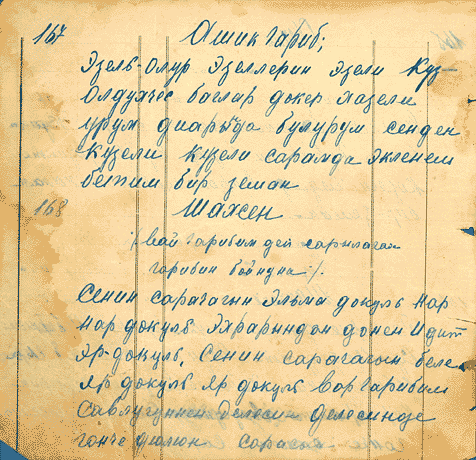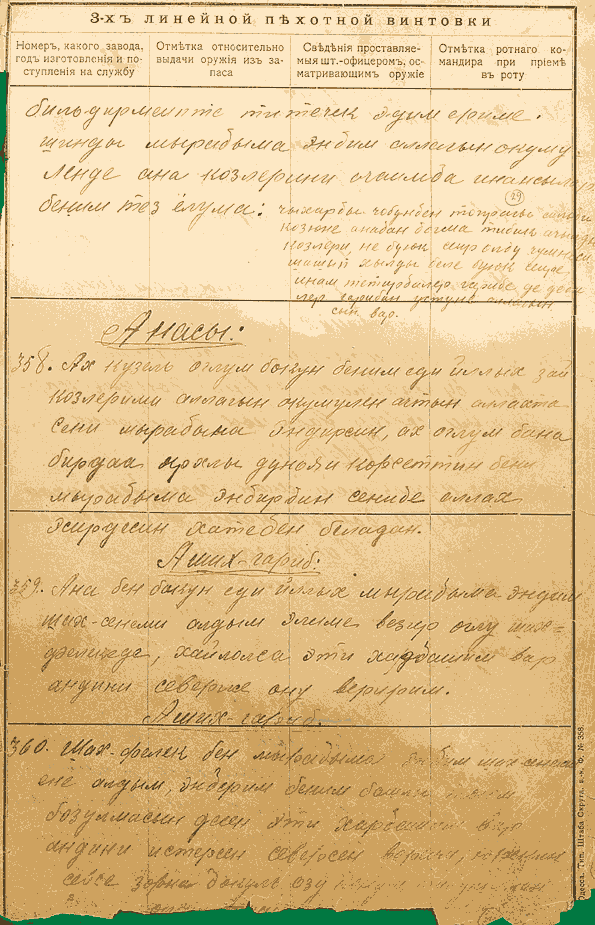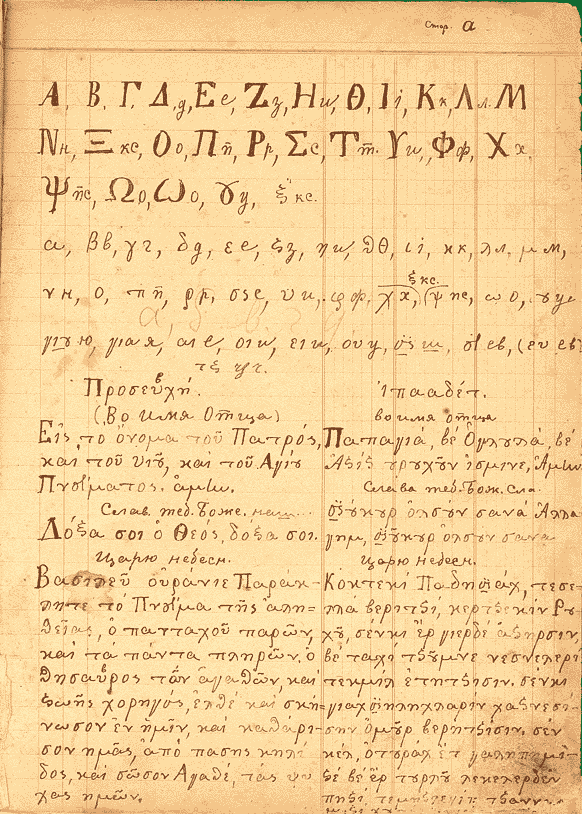MEMORIALS
WRITTEN MONUMENTS OF TURKIC LANGUAGES
The section represents electronic versions of written monuments, including epigraphic writings, that have a direct or indirect attitude to Turks, and memorials of their folklore.
To read, to type and to process the texts of the represented memorials adequately, it is necessary to copy and install the fonts, contained in the Fonts section, on your computer.
All of our files, if not stipulated especially, are formatted in Microsoft Word 6.0 / Windows 95.
Turkic Runic and Greek inscriptions on vessels of so-called
«Attila treasure» from Nagy-Szent-Miklos, Romania
The review placed on this site is prepared in Russian by A. Garkavets in accordance to V.Tomsen, J.Nemet, F.Altheim and S.Bajchorov’s publications. Illustrations are given under the book: Lásló Gy., Rácz I. A Nagyszentmiklósi kincs.– Budapest: Corvina Kiadó, 1977.
Files Inscripr.doc (66 Kb) or Inscripr.zip (15 Kb) are formatted in Microsoft Word 8.0 / Windows XP.
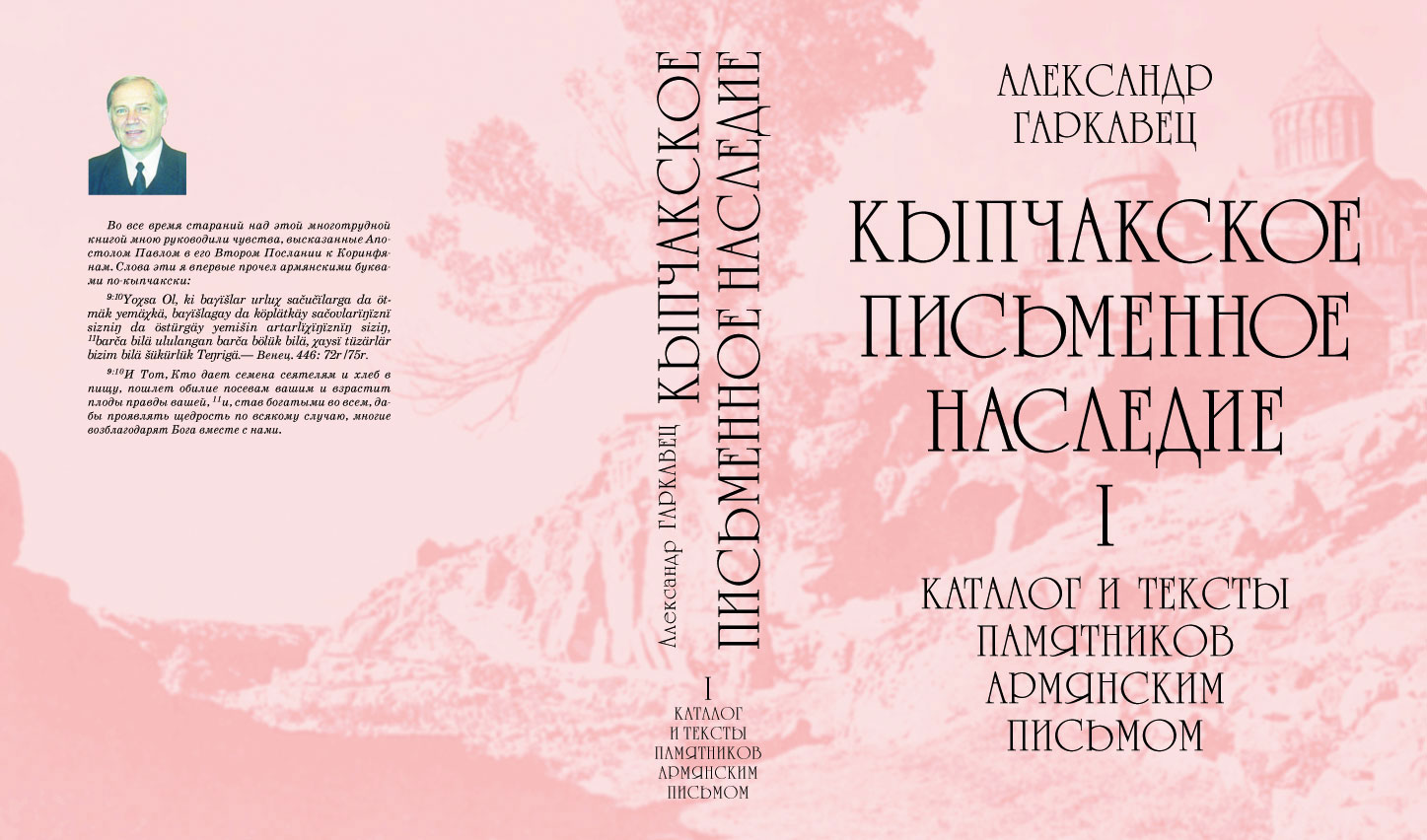
Alexander Garkavets.
Qypchaq Written Heritage.
Volume I. Catalogue and Texts of Monuments Written in Armenian Script.
Russian Version.– Almaty: Desht-i Qypchaq, 2002.– 1084 p.
In this treasury of Old-Qypchaq (Qypchaq – Kypchak – Kipchak – Êûï÷àê – Êèï÷àê – Êûïøàê – Õûï÷àõ – Òàòàð) literature presented 109 manuscripts of 1519-1689 and first-ever Qypchaq book printed from metal type-setting forms in 1618 in Lviv by Ovannes Karmadanents.
Magic movements of human spirit and surprising details of the life, refined antiquities of Turkic syllable and courageous word innovations will amaze you in this unique collection where we have included: 3 chronicles, 5 Psalters, all Letters of apostle Paul, 9 Prayer books, 2 hagiography collections, 3 Codes of laws, 3 Remedial codes, numerous compositions on theosophy, didactics, histories of religion and church, cosmologies, astrologies, selections, chemistry, medicine, calendars, documents of self-management Qypchaq speaking Armenians of Kamenets-Podolsk, Lviv, Stanislav and individuals, samples of Armenian-Qypchaq dictionaries and glossaries of 16-17 centuries.
Total amount of the monuments, collected from libraries and archives of Austria, Armenia, Italy, Netherlands, Poland, Russia, Romania, Ukraine and France and presented in this volume in Latin transcription, over 3,5 million symbols.
The cover in grayscale. The file CoverQ1.pdf (163 Kb).
The last page of the cover in CMYK. The file Cover.pdf (77 Kb) .Titles and Annotation. The file Title.pdf (47 Kb).
Introduction. The file 001-Intr.pdf (396 Kb).
Catalogue and texts of Qypchaq manuscripts written in Armenian Script kept in several countries:
Qypchaq manuscripts written in Armenian Script kept in Armenia. The file 269-Arm.pdf (245 Kb).
Qypchaq manuscripts written in Armenian Script kept in Austria. The file 029-Aus.pdf (1052 Kb).
Qypchaq manuscripts written in Armenian Script kept in France. The file 975-Fra.pdf (546 Kb).
Qypchaq manuscripts written in Armenian Script kept in Italia. The file 306-Ita.pdf (1734 Kb).
Qypchaq manuscripts written in Armenian Script kept in Netherlands. The file 661-Neth.pdf (210 Kb).
Qypchaq manuscripts written in Armenian Script kept in Poland. The file 675-Pol.pdf (886 Kb).
Qypchaq manuscripts written in Armenian Script kept in Romania. The file 866-Rom.pdf (47 Kb).
Qypchaq manuscripts written in Armenian Script kept in Russia. The file 867-Rus.pdf (75 Kb).
Qypchaq manuscripts written in Armenian Script kept in Ukraine. The file 871-Ukr.pdf (692 Kb).
Table of Contents – in the file France. The file 975-Fra.pdf (546 Kb).
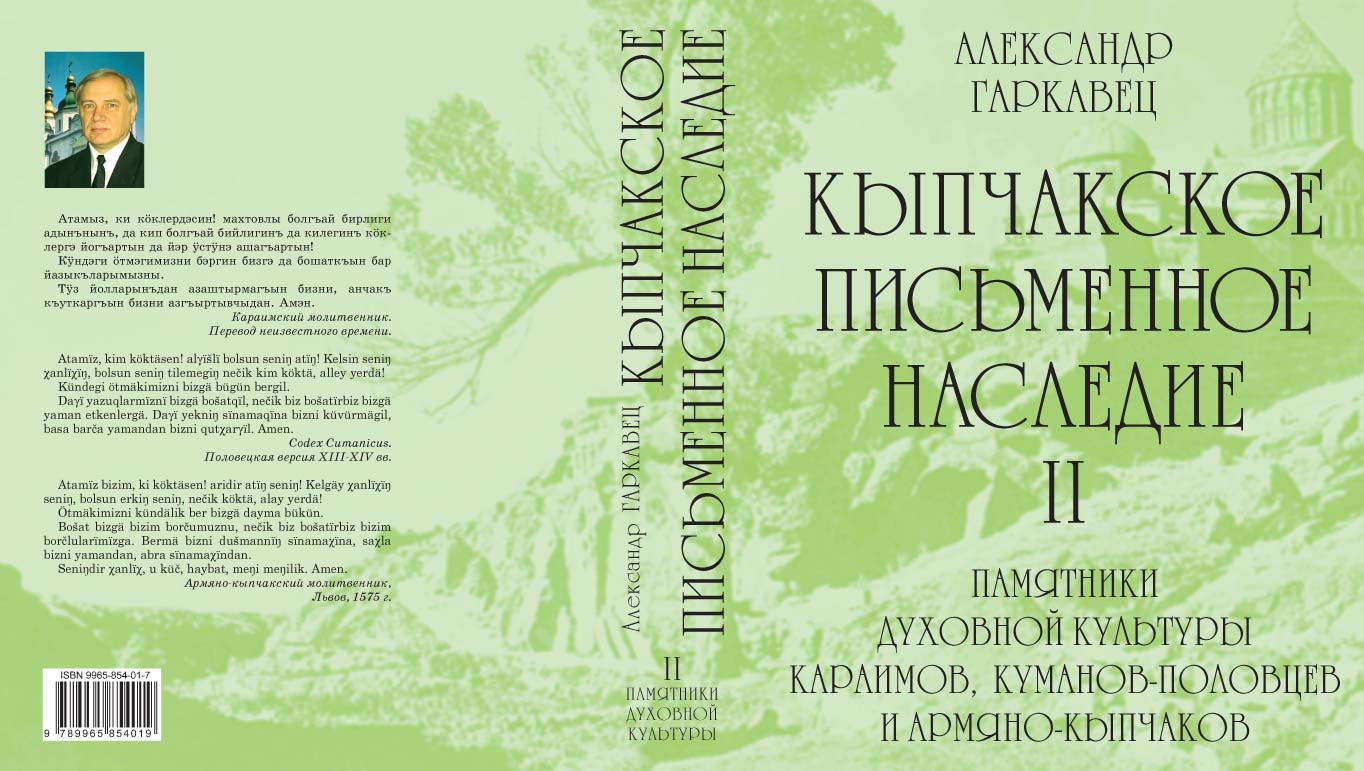
Alexander Garkavets.
Qypchaq Written Heritage.
Volume II. Monuments of Spiritual Culture. Russian Version.–
Almaty: KASEAN; BAUR,
2007.
- 912 p.
Accessible parts:
Titles and the Foreword
The file i-vi_Title2.pdf (49 Kb).
Karaim Prayer Book
The file 001-062-Karai.pdf (287 Kb).
Codex Cumanicus: Cuman Prays, Hymns and Riddles
The file 063-120ÑÑ.zip (360 Kb).
Qypchaq Sermons by Anton Vartabed
(3 volumes, 125 sermons)The file 121-646_Anton.zip (2382 Kb).
Qypchaq Dictionaries to the Armenian Bible
The file 647-884_Glossary.zip (1240 Kb).
A Qypchaq Glossary to the Armenian Psalter
The file 885-894_2267 (96 Kb).
An Armenian-Qypchaq Manual in Dialogues on Grammar, Theology, Philosophy and Systematics
The file 895-906_3522.zip (93 Kb).
Alexander Garkavets.
Qypchaq Written Heritage.
Volume III. Qypchaq Dictionary.–
Almaty: Baur, KASEAN,
2010.
– 1802 pages
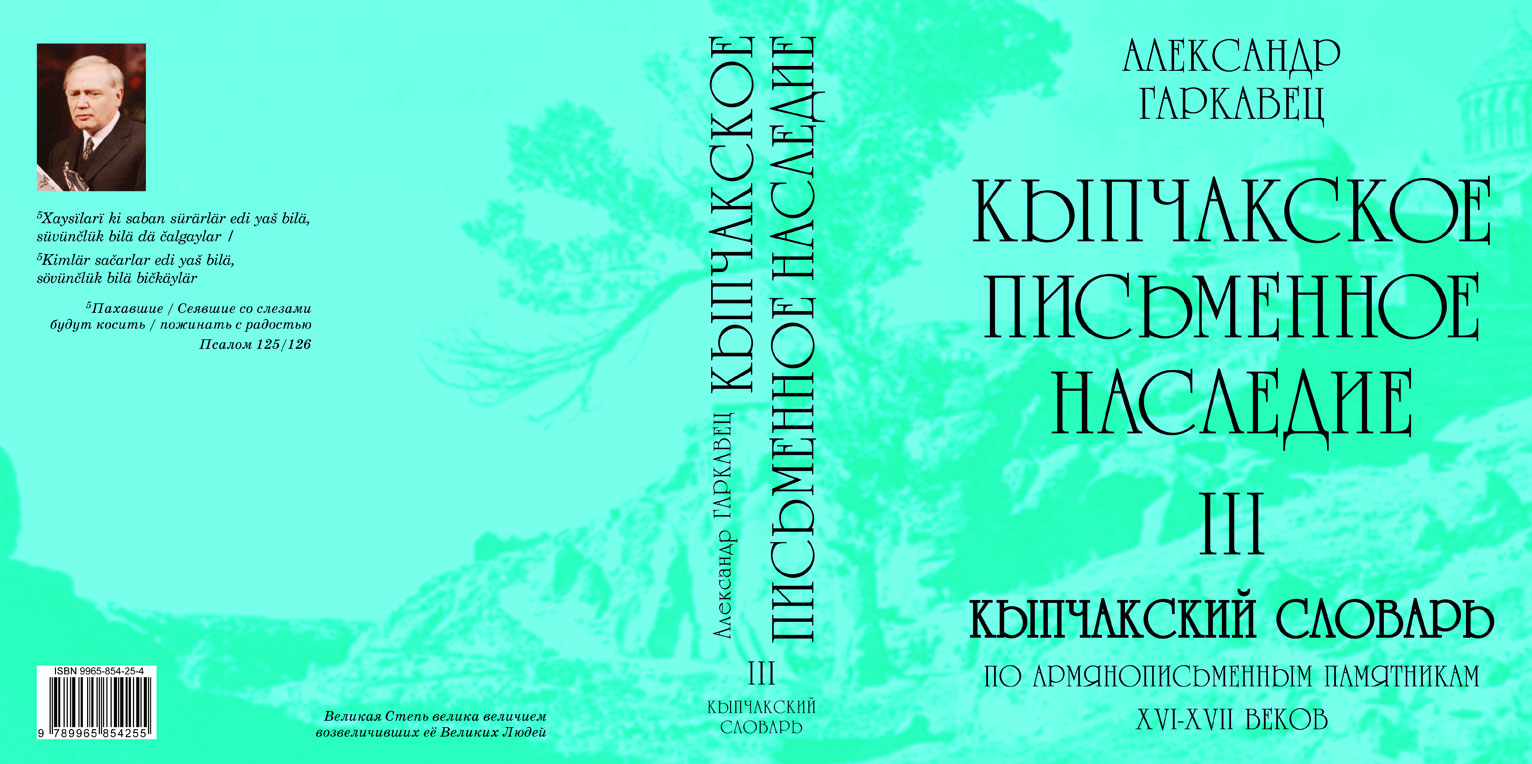
Alexander Garkavets. Qypchaq Dictionary. A Separate Edition
. – Almaty: Almatykitap Baspasy, 2011. – 1802 pages.
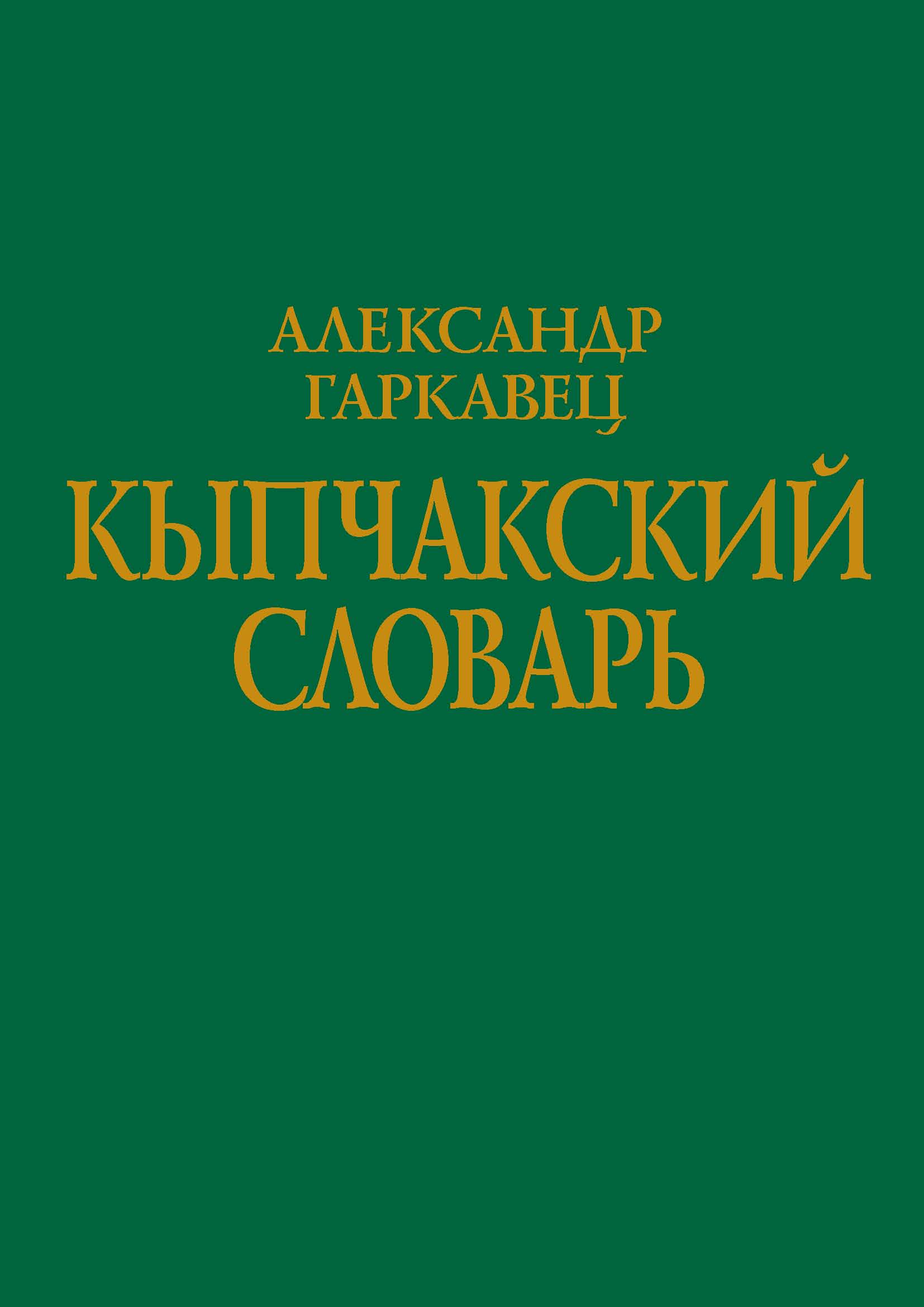
The whole book is represented in three colors: black for body text, blue for marked texts and dark red for Armenian.
The file: A-Q-Dic_0001-1802_RGB.pdf (18 606 Kb).
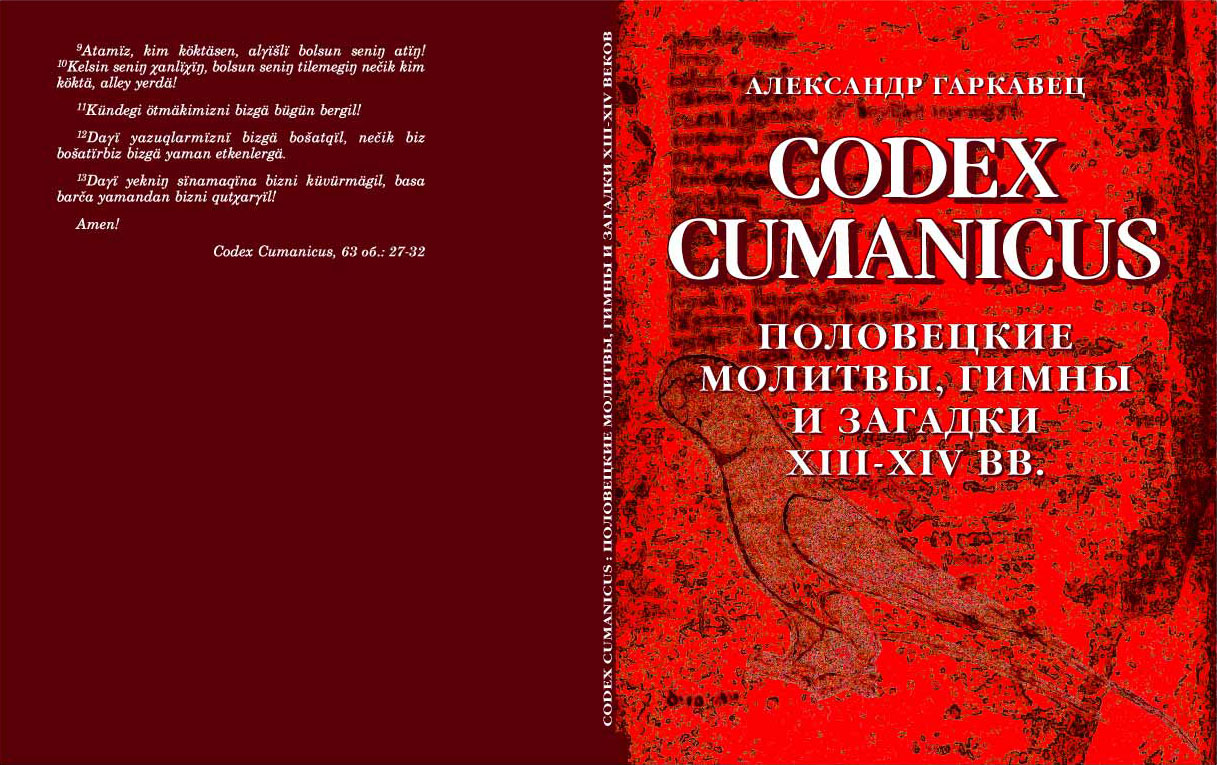
Alexander Garkavets.
Codex Cumanicus: Qypchaq-Cuman-Polovets texts XIII-XIV centuries. -
Almaty: Desht-i Qypchaq, Baur,
2004.
- 60 pp.
It is a first full Russian edition unique Qypchaq-Cuman-Polovets texts, apparently, well-known, but, by and large, a known to nobody monument which has been submitted to the Russian and global scientific community by Henrich-Julius
Klaprot in 1828. Later "Codex Cumanicus" many times was issued in Latin, German and French. Riddles and some texts, not up to the end read and translated, were appeared also in Russian and other languages.In the Codex are submitted: the earliest in a history a collection from 47 Turkic riddles and for the first time translated to Qypchaq-Cuman-Polovets language «Ten Divine Precepts»,
fragments from «The Book of parables» of Solomon, Gospels and works of St. Gregory (329/330-389/390), St. Ambrose (339-397), St. Jerome (340/345-420) and St. Augustine (354-430), «Creed», prays «Pater noster» and «Ave, Maria», hymns of Coelius Sedulius (d. 450), Venantius Fortunatus (530/540-600), Theophilus from Saint Aubin (XII-XIII centuries) and other latin poets - «Ave, porta paradisi», «Jesu, nostra redemtio», «Verbum caro factum est», «Vexilla regis prodeunt», «Reminiscens beati sanguinis», «A solis ortus cardine» and original Cuman sermons.We have supplied religious texts historical information, comments and latin equivalents. Originals of the majority of them hundred years ago have established William Bang and Charles Saleman.
Texts are prepared for printing under the facsimile of the manuscript of the Code kept today in the Mark Evangelista cathedral library in Venice (Biblioteca Divi Marci
- Biblioteca Nazionale di S. Marco - Biblioteca ad templum Divi Marci Venetiarum, Venezia, Mss. latini, Fondo antico, Collocazione 1597, Codex DXLIX / ¹ 549), in view of invaluable publications of Henrich-Julius Klaprot, Geza Kuun, Hermann Vambery, Wilhelm Bang, Vasily Radloff, Karl Salemann, Otto Blau, Julius Nemeth, Kaare Grønbech, Dagmar Drüll, Andreas Tietze, Mefküre Mollova, Vladimir Drimba, etc.Cuman
texts are given in earlier developed by us a Turkological transcription on Latin basis for Qypchaq monuments and according to principles of reading of Turkic texts of the Codex, stated in our monography «Qypchaq languages: Cuman and Armeno-Qypchaq» (Alma-Ata: Nauka, 1987) where the exhaustive table of conformity of written signs to sounds Polovets speeches is resulted and is shown evolution of graphic system of a monument.All of Qypchaq lexicon of published texts and the Codex as a whole is included in ours
«Qypchaq dictionary» finished by us by the second volume of the «Qypchaq written heritage» (see above).The cover: Cover.pdf (562 Kb).
Titles and the announcement: 001-004.pdf (91 Kb).
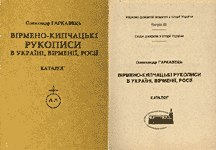 Alexander Garkavets.
Alexander Garkavets.
Armeno-Qypchaq manuscripts in
Ukraine, Armenia, Russia: Catalogue.
Second, revised edition.
-
Almaty:
Desht-i Qypchaq,
2002.
Ukrainian verson
with Latin transcription in Qypchaq-Diacritic font.
Russian version
with Latin transcription in Qypchaq-Diacritic font.
The first Ukrainian edition (Kyiv, 1993) with Cyrillic transcription in Bookman Urum font.on the regional materials: Olexandr Harkawets'. Armeno-Kipchak manuscripts in Ukraine, Armenia, Russia: Catalogue.– [On the title:] Academy of Sciences of Ukraine: Institute of Ukrainian Archaeography; The A.Krymsky Institute of Oriental Studies. – The Central State Historical Archive of Ukraine, Kiev.– Kyiv: Ukrainoznavstvo, 1993.
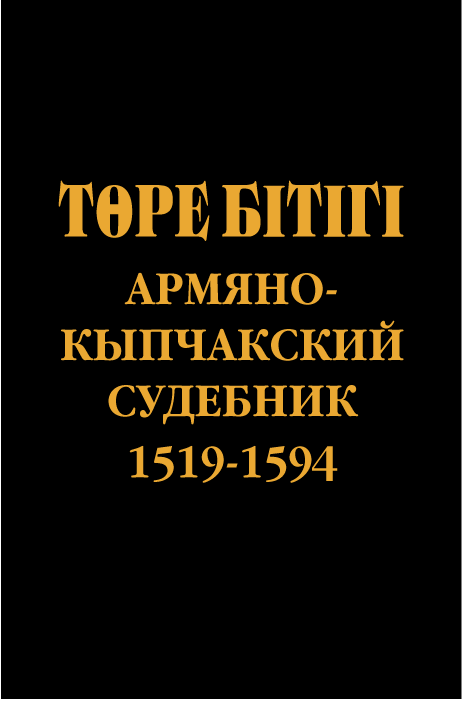 Qypchaq-Polish
version of the Armenian Code of Laws and Armeno-Qypchaq Code of Practice,
1519-1594 / Ed. by Alexander Garkavets and Ghairat Sapargaliev.- Almaty:
Desht-i Qypchaq, 2003.– 792 pp.
Qypchaq-Polish
version of the Armenian Code of Laws and Armeno-Qypchaq Code of Practice,
1519-1594 / Ed. by Alexander Garkavets and Ghairat Sapargaliev.- Almaty:
Desht-i Qypchaq, 2003.– 792 pp.
22 February, 2002 the first electronic edition (2001) is revised in accordance to clausing the Polish version (1604) of the Lviv Armeno-Qypchaq “Code of Practice” by Oswald Balzer.
On July, 26, 2002 the essential proof-reading is executed.
On December, 25, 2002, executed a new proof-reading and added Qazaq translation and Qypchaq-Qazaq Glossary, compoused by Ghairat Sapargaliev.
22 April, 2003, final edition, including Latin text, Ukrainian translation, an article of Myron Kapral' and any new illustrations.
7 Julay, 2003, the hard version of the book was printed by the Justice Institute of Kazakhstan Justice Ministry. You can ask for the book in Almaty office of the Justice Institute, tel.: 695709.
Armenian "Code of Laws" was translated from Old-Armenian into Latin language in Lviv and authorized by Polish king Sigizmund in 1519 for the Lviv Armenian court with essential corrections and additions. Translation from Latin into Polish and Qypchaq was made also in Lviv 1523.
A. Garkavets prepared the monument for printing according to three manuscripts from Wroclaw, Paris and Vienna by request of the Kazakh State Juridical Academy and International Centre of Qypchaqology in 2001.
The Wroclaw manuscript of 1523 contains 53 additional Qypchaq articles more, than the Parisian manuscript of 1568 and Viennese of 1575. Therefore, we have taken it as basis to compose a critical text. The primary source kept Qypchaq texts yet not found, and, probably, lost.
In the Central State Historical Archive of Ukraine in Kyiv there is a positive microfilm of the Wroclaw manuscript, but the page 168r, unfortunately, is missing in this copy.
The publishers express gratitude to experts of UNESCO Sergey Karpov (Almaty) and Jack Skillen (Paris) and to the Ambassador of Armenia in Kazakhstan Eduard Khurshudian for the help to order microfilms of Parisian and Viennese manuscripts of the "Code of Laws".
Today we offer to the attention of visitors of our site:
-
Titles, the foreword, two illustrations, the Correspondence table of the Qypchaq version to the Armenian prototype, prepared by A. Garkavets.
The file Qypchaq-Laws-001-014.pdf (413 Kb), prepared by A.Garkavets.
-
The Qypchaq version of the Armenian "Code of Laws" of Mekhitar Gosh in A.Garkavets's transcription, a critical text with Russian translation. The critical text based on the manuscript 1916/II of 1523 kept in Library of National institute of Ossolinsky, Wroclaw, Poland. The Qypchaq part of the manuscript includes the basic text (pages 1v/156v-142r/297r) translated from Polish into Qypchaq; new articles 1-5 brought in translation initially (pages 56v/211v-63r/218r) and new additional Qypchaq articles 6-99, including the last (99th) addition of 1594 (pages 142v/297v-164r/319r). The manuscript was written and used in Lviv. In footnotes are given alternatives of two other manuscripts.
The file Qypchaq-Laws-015-199.pdf (961 Kb).
The Qypchaq text of 1523 in original Armenian script, prepared by A.Garkavets.
The file 1916arm.doc (252 Kb).
-
The Qypchaq version of the Armenian "Code of Laws" of Mekhitar Gosh in A.Garkavets's transcription of the manuscript of 1568 from Kamenets-Podolsky, kept in National library, Paris, France, Arm. 176, pages 1r-113r. The copy dated February 15, 1017/1568 (page 113r). It is similar to the Viennese manuscript No.468 and is a copy of the lost incomplete praecopy. The manuscript contains translation of the basic text into Qypchaq (pages 1r-105r); additional articles 1-5 brought in translation initially (41r-51bis r); and additional Qypchaq articles 6-31, 33-48 (pages 51 bis v - 112r). On the page 112v there is a remark that the "Code of Laws" was translated «into Tatar language» from Armenian, but we know from other manuscripts, that translation into «our language» was made from Polish, into Polish - from Latin, and into Latin - from Armenian. By a name of one of its users (Ivashko, the son of eretspokhan "seniorman" Sergey, who was the voyt of Kamenets Armenians) we can conclude, that the copy was used in Kamenets-Podolsky.
The file Qypchaq-Laws-200-341.pdf (511 Kb).
note: the text of the Parisian manuscript occupies left pages in the same file, where the text of the Viennese manuscript is placed on the right.
The file 176arm.doc (230 Kb)
The Qypchaq version of Armenian “Code of Laws” of Mekhitar
Gosh in A.N.Garkavets's transcription
of the manuscript of 1575 from
Kamenets-Podolsky, kept in the Mekhitaristen Congregation Library, Vienna,
Austria, No. 468, pages 3r-127r.
The text dated December 20, 1024/1575 (126v). It
is similar to Parisian manuscript Arm. 176 and is a copy of the lost
incomplete praecopy. The manuscript contains translation of the basic text
into Qypchaq (pages 3r-28v, 68v-127r); additional articles 1-5 brought in
translation initially (72v-76r); and additional Qypchaq articles 6-31, 33-48
(119r-127r). Editorial changes in the text of the “Code of Laws” (pages
118v, 126v) and historical notes and colophones on first and last pages of
the manuscript show that the copy was used in Kamenets-Podolsky.
The file
Qypchaq-Laws-200-341.pdf (511
Kb).
note:
the text of the Viennese manuscript occupies right pages in the same
file where the text of the Parisian manuscript is placed on the left.
The
Qypchaq text of 1575 in original Armenian script,
prepared by A.Garkavets.
The file
468arm.doc (226 Kb)
The Armenian prototype of the Qypchaq
versions of the “Code of Laws” of Mekhitar Gosh translated into Russian from
Old-Armenian by A.Papovian according to the V.Bastamian's edition of 1880,
based on the
Matenadaran manuscript No.488 of 1295 and more
than ten other copies. It is prepared
according to the edition: Armenian “Code of Laws” of Mekhitar Gosh /
Translated from Old-Armenian A.Papovian. Edition, introductory article and
notes written by M.Arutiunian. – Yerevan: Publishing house of the Academy of
Sciences of Armenian SSR, 1954. - 269 pages
(In Russian). The full Armenian text of the
“Code of Laws” of Mekhitar Gosh and A.Papovian's Russian translation can be
found
at this address:
www.digilib.am_gosh.
The formulations of
legal norms borrowed from the Bible, kept in the text of the Mekhitar Gosh’s “Code
of Laws” and in A.Papovian's translation, differ from the appropriate
original expressions, because Mekhitar Gosh
followed the Armenian
translation of the Sacred Scripture and
A.Papovian tried to reflect specificity of the
Armenian original.
Therefore, we,
wishing to release our grateful readers from this routine
work, have found necessary to address to the primary
source, to recheck all references, to make necessary specifications, to
exclude erroneous
references, to add missing,
and to open all these references.
References to books of
the Old Testament and the New Testament are specified, added and opened by
A. Garkavets in conformity
to the electronic version of Synod translation of
the Bible of the Moscow Patriarchy 1876 / 1956 (http://www.bible.ru)
and the book edition: The Bible. Books of the Old Testament and the New
Testament in Russian translation with additions. 4th editions. - Brussels:
Publishing house “Life with God”, 1989. - 2535 pages. Abbreviations of books
titles in the references, prepared by A.Garkavets, conform to Russian
standard,
but in the A.Papovian’s translation the references abandoned without
changes.
To the text is applied
the brief Armenian glossary made by us according to B.M.Arutiunian comments.
The publisher thanks
Tatyana Ivanovna Klochko-Kajdalova for professional proofreading
of A.A.Papovian’s translation and the references, prepared by us to books of
the Sacred Scripture.
The file
Qypchaq-Laws-342-445.pdf (437
Kb).
The
Latin version of the Armenian “Code of Laws” published by
Myron Kapral' on the basis of the
Privilegue for Lvov Armenians
1519:
Êàïðàëü Ì. Ïðèâ³ëå¿
íàö³îíàëüíèõ ãðîìàä ì³ñòà Ëüâîâà (XIV-XVIII ñò.).– Ëüâ³â, 2000.
The file Qypchaq-Laws-446-503.pdf
(323 Kb).
The Polish
version of the Armenian “Code of Laws” published by the priest and historian
Sadok Baracz on the basis of two copies, of which the publisher
informs the following:
“In my
hands were two copies of the Armenian laws: one, written by the Gothic
script, containing 124 units, the second copy, in which section 122 was
divided into two units, that
is why numbering 125 sections.
On these
manuscripts
for some years worked Romuald Hube, former minister of public
education in Poland and the state senator, with a view of the edition of
extensive research about legal proceedings of Armenians” (page 261).
The monument
is edited according to the mentioned below source with preservation of the publishers
orthography:
Sadok Barącz. Rys dziejów Ormiańskich.- Tarnopól: Drukiem Józefa
Pawłowskiego, 1869.- Ñòð. 205-261.
The publication is prepared by A.
Garkavets.
The file Qypchaq-Laws-504-545.pdf
(280 Kb).
The Polish version (1604) of the Lviv Armeno-Qypchaq “Code of Practice”, 1523-1594, published by Oswald Balzer on the basis of the earliest from ten copies of XVI - first half XIX, kept in Poland and Ukraine.
The Polish text, according to the source (see a preamble), “was truthfully translated directly from the Armenian original into Polish and then is copied under the order and by diligence of the Lviv Armenian sirs, being in 1604”. The “Armenian original” expression should be understood especially in graphic sense: actually, the original was only written by the Armenian script, not in the Armenian language, but in Qypchaq.
It turned out, that the additional articles of the judicial procedure maintenance included in published Qypchaq version of the Armenian “Code of Laws” is just origin of the Armeno-Qypchaq “Code of Practice”. The original Qypchaq text was thoroughly advanced and considerably expanded, according to requirements of time. The initial composition is essentially changed also.
The Polish "Order of courts and cases of the Armenian right” was divided by composers into 10 sections.
Division of the text into 132 articles was executed by Oswald Balzer.
The monument is edited according to the mentioned below source with preservation of the publisher’s orthography:
Porządek sądów i spraw prawa ormiańskiego z r. 1604 / Wydał i wstępem opatrzył Oswald Balzer // Studya nad historyą prawa polskiego, wydawane pod redakcyą Oswalda Balzera.– Tom V, zeszyt 1.– Lwow, 1912.
On first pages are given bilateral comparative tables of Qypchaq and Polish versions of the Lviv Armeno-Qypchaq “Code of Practice”.
The monument is prepared for the publication and translated from Old-Polish into Russian by A.Garkavets.
The file Qypchaq-Laws-546-596.pdf (248 Kb).
A Glossary to Qypchaq version of
the Armenian “Code of Laws”, composed by A. Garkavets.
The Glossary includes legal terms,
other social and economic terminology, names of people,
onomastic names and
ethnonyms, and everyday lexicon having the important value for legal
style of Armeno-Qypchaq language.
Proper names
are given in the
united list after appellatives.
Words and
word-combinations borrowed from Armenian, Greek,
Jewish, Italian, Latin, German, Polish, Slavic and Ukrainian
languages have special
remarks.
The Armenian borrowings, as well as in the text, are given in armenistic
transliteration, which only here, if necessary, accompanied by turkological
transcription, where as in the basic text Armenian borrowings are given only
in transliteration with elements of transcription.
Borrowings from Old-Turkish,
Mongolian, Turkish, Crimean Tatar, Karaim, Arabian and Persian languages,
making an integral part of the basic lexical fund of the Armeno-Qypchaq
language, are not marked by special notes.
40 pages. 1270 header words.
The publication is prepared by A.
Garkavets.
The file Qypchaq-Laws-596-636.pdf
(323 Kb).
The Qypchaq
version of the Armenian "Code of Laws" of Mekhitar Gosh in Qazaq
translation by
Ghairat Sapargaliev's.
The file Qypchaq-Laws-637-716.pdf (263
Kb).
A Qazaq
Glossary to Qypchaq version of
the Armenian “Code of Laws”, prepared by
Ghairat Sapargaliev.
The file
Qypchaq-Laws-717-740.pdf
(116 Kb).
The article
of Myron Kapral' “The
legal status of the Lvov Armenian community in XIV-XVIII centuries: the
review of documents”.
The file Qypchaq-Laws-741-754.pdf
(91 Kb).
The article
of
A.Garkavets “Qypchaq speaking Armenians and Qypchaq heritage
written by Armenian script,
XVI-XVII centuries”.
The file Qypchaq-Laws-755-776.pdf
(268 Kb).
The
list of the
literature on Armeno-Qypchaqology
composed by
A.Garkavets and completed by Maksym Tsymbal.
The document finishes a table of contents of the
print version of our edition of Armeno-Qypchaq Code of Laws.
The file
Qypchaq-Laws-777-792.pdf
(136 Kb).
The electronic and hard versions of our publication
are identical.
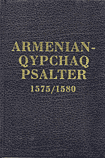 Armenian-Qypchaq Psalter written by deacon Lussig from Lviv, 1575/1580.
Armenian-Qypchaq Psalter written by deacon Lussig from Lviv, 1575/1580.
The monument is published in September 2001 by Alexander Garkavets and Eduard Khurshudian according to manuscripts of the Austrian national library, Vienna, Cod. Arm. 13 and of the Library of the National museum, Chartorysky branch in Krakow, Poland, the manuscript 3546/III:
Armenian-Qypchaq Psalter written by deacon Lussig from Lviv, 1575/1580
/ Edited by A.Garkavets, E.Khurshudian.– Almaty: Desht-i-Qypchaq, 2001.– 656 pp.
Today here on our site are accessible:
Qypchaq translation of 1575 in original Armenian script, prepared by A. Garkavets.
Files 3546qypa.doc (337 Kb) or 3546qypa.zip (115 Kb).Qypchaq translation of 1575 in turkological transcription, prepared by A. Garkavets.
Files 3546-qyp.doc (317 Kb) or 3546-qyp.zip (110 Kb).Qypchaq translation of 1580 in original Armenian script, prepared by A. Garkavets.
Files 13-qypa.doc (358 Kb) or 13-qypa.zip (125 Kb).Qypchaq translation of 1580 in turkological transcription, prepared by A. Garkavets.
Files 13-qyp.doc (349 Kb) or 13-qyp.zip (119 Kb).Armenian original of 1575 in West Old-Armenian script, typed by Ruzan Sarkissian. Edited by A. Garkavets and E. Khurshudian.
Files 3546-arm.doc (310 Kb) or 3546-arm.zip (118 Kb).Armenian original of 1580 in West Old-Armenian script, typed by Ruzan Sarkissian. Edited by A. Garkavets and E. Khurshudian.
Files 13-arm.doc (324 Kb) or 13-arm.zip (126 Kb).Armenian-Qypchaq glossary of deacon Lussig from Lviv, prepared by A. Garkavets and E.Khurshudian according to the manuscript 2267 from Matenadaran.
Files 2267-arq.doc (101 Kb) or 2267-arq.zip (33 Kb). The corrected edition of this glossary: 2267-arq_556-582.pdf (242 Kb) or 2267-arq_556-582.zip (220 Kb.The article of A. Garkavets “Mysterious Ukrainian Armenians who spoke, wrote and prayed on Qypchaq and 400 years ago have published first-ever Qypchaq book”, concluding the book.
The file These_Mysterious_Ukrainian_Armenians.pdf (390 Kb).To facilitate our users search of Russian translations of Psalms, prays and hymns included in Armenian-Qypchaq Psalter, we have collected them in one file in the order in which they follow one after another in Psalter of deacon Lussig from Lviv. As a source is used Synod translation.
Files Ps_ru.doc (301 Kb) or Ps_ru.zip (108 Kb).
